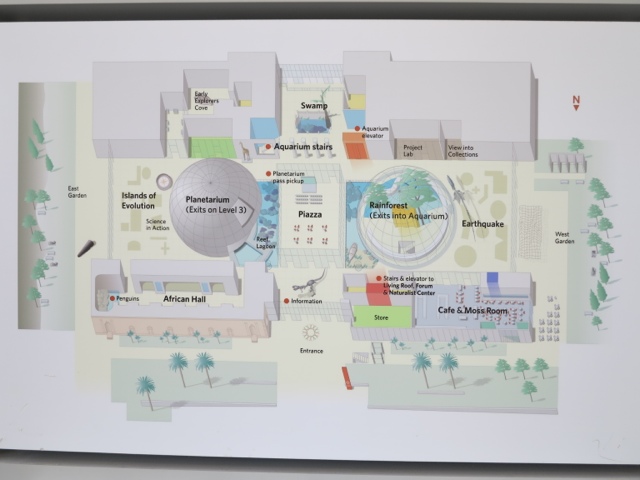The academy buildings were damaged significantly in the1989 earthquake. As plans were made to repair the damage and make the buildings seismically stable, it was realized that a considerable amount of work would be needed to bring the buildings up to modern standards. This led to the idea of giving the academy a complete overhaul, and in turn the demolition of the old buildings.The new $500 million building reopened in September 2008.
Italian architect Renzo Piano was appointed to design the building. Other notable examples of his work include the Pompidou in Paris (1971, with Richard Rogers), Aurora Place in Sydney, 2000, Parco della Musica in Rome, 2002, and the Shard in London, 2012.
The new academy building includes an array of environmentally friendly features. It produces 50 percent less waste water than previously, recycles rainwater for irrigation, uses 60,000 photovoltaic cells, uses natural lighting in 90 percent of occupied spaces, and was constructed with an enormous amount of recycled steel and concrete.
The project conserves two limestone walls from the previous building (1934), and houses a planetarium, a rain forest habitat and an aquarium, and several exhibition spaces to house the several Academy collections.
The planetarium and the bubble that contains the rain forest habitat are the two big spheres that shape the green roof. The roof becomes a landscape with California native species, that won´t need extra maitenance or water, attracting local species to occupy it. Thus, the green roof won´t be fully accesible to visitors, who can only walk through a small path.
The designers were sensitive to the appearance of the building in its natural setting.
The entire exterior is clad in copper, which is expected to eventually oxidise, and take on a greenish tone and a distinct texture to echo the nearby eucalyptus trees. The copper panels are dimpled, and some are perforated.
In order to further harmonize with the surroundings, shapes were cut into the top to reveal gardens and courtyards where 48 trees had been planted, the giant tree-ferns that form a backdrop for the museum entrance are particularly dramatic. New landscaping was planted with many transplanted trees and boulders.
The building is clad with variably perforated and dimpled copper plates, whose patina will slowly change through exposure to the elements.
A 144 ft. (44 m) observation tower allows visitors to see much of Golden Gate Park and rises above the Park's treetops providing a view of the Golden Gate Bridge and Marin County beyond. It also provides a fine view of Renzo Piano's Academy of Sciences building, directly opposite.
The de Young, like many art museums outside the UK, is happy for visitors to take photographs, provided they don't use flash or tripods. I would not be allowed to photograph this David Hockney sketch in a UK gallery.
| Established | |
|---|---|
| Location | Golden Gate Park, San Francisco, California, United States |
| Type | Natural History |
| Visitors | Over 1 million visits annually |
| Director | Gregory C. Farrington |
| Website | www.calacademy.org |



































No comments:
Post a Comment